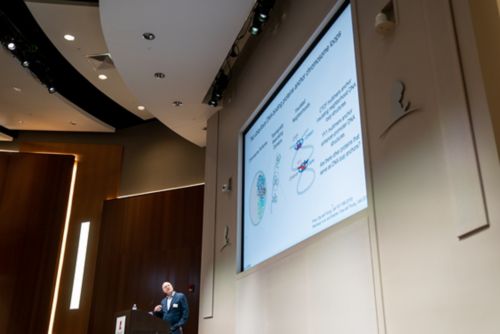St. Jude Family of Websites
Explore our cutting edge research, world-class patient care, career opportunities and more.
St. Jude Children's Research Hospital Home

- Fundraising
St. Jude Family of Websites
Explore our cutting edge research, world-class patient care, career opportunities and more.
St. Jude Children's Research Hospital Home

- Fundraising
About the collaborative
The St. Jude Transcription Collaborative was established in 2019. The team aims to unravel the intricate nuclear and chromatin architecture driving malignant characteristics of pediatric cancers. Its goal is to identify promising therapeutic targets by understanding dysregulated genome structure and gene expression. By leveraging the power of large-scale, integrative computational analysis, the consortium is comprehensively examining complex and multifaceted biological processes, culminating in a greater understanding of chromatin characteristics in cancer.

How DNA is spatially organized within a cell’s nucleus is connected to gene regulation, making it necessary to understand physical nuclear organization and its biological causes and consequences. Some notable successes from the consortium include projects looking at the roles of looping proteins and DNA elements and the drugs that affect them.
The cohesin protein complex physically connects specific DNA elements, but its components can be mutated in many cancer types. The Stegmaier and Young labs investigated the effects of mutations in the STAG2 protein on gene regulation and metastasis in Ewing sarcoma. They discovered that an alternate protein, STAG1, partially but incompletely compensates for dysfunctional STAG2, but loss of both proteins is lethal to these cancer cells. Interestingly, the loss of STAG2 had widespread effects on gene expression, including regulation of genes controlling metastasis. The work was published in Cancer Cell.
Two projects converged on the oncogene FOXR2, to illustrate how alterations in the non-coding genome, or in the epigenome drive aberrant expression. In work published in Acta Neuropathologica, the Zhang and Baker labs discovered a novel genomic integration of a LINE1 transposable element in a pediatric high-grade glioma, introducing a promoter that misactivates FOXR2 expression. The teams also showed in Cancer Research that FOXR2 expression could be activated by epigenetic activation of a cryptic promote in high-grade glioma. This mechanism of FOXR2 misactivation was widespread across diverse tumor types.

The Young, Look, and Abraham labs investigated how compounds called retinoids drive neuroblastoma cells to differentiate along the developmental pathways of normal cellular counterparts. The team showed that this occurs through changes in the activities of elements that loop chromatin, forcing a new gene expression program to emerge. The findings were published in Science Advances.
Understanding how and why proteins form liquid-liquid phase-separated nuclear condensates is one of the major frontiers in biomedical research. The Young lab, leaders in this area, demonstrated in Developmental Cell that mutations of expression-regulating proteins could affect the properties of their condensates. Together, the Young and Abraham labs, as part of an extensive team, studied condensates from another angle, focusing on promoter elements. The team found a protein called RONIN that occupies and connects certain gene promoters. The study was published in Cell Reports and opens a new avenue for investigating genome structure.
These findings exemplify how this cross-disciplinary team is making advances in the mechanistic understanding of malignant gene expression programs by combining expertise in specific diseases with deep knowledge of the underlying biology. In addition to these and other publications, a major focus of the consortium is deploying sophisticated applied sequencing technologies to models of pediatric cancers at scale. To this end, the consortium has generated hundreds of valuable genome-wide datasets applicable not only to the disease interests of the group but to the research community.

Collaborative Members
Lead: Suzanne Baker, PhD – St. Jude Children’s Research Hospital
A. Thomas Look, MD – Dana-Farber Cancer Institute
Kimberly Stegmaier, MD – Dana-Farber Cancer Institute, Broad Institute
Richard A. Young – Whitehead Institute for Biomedical Research, MIT
Jinghui Zhang, PhD – St. Jude Children’s Research Hospital
Core for Genomics Assays
- Brian Abraham, PhD – St. Jude Children’s Research Hospital
- John Easton, PhD – St. Jude Children’s Research Hospital